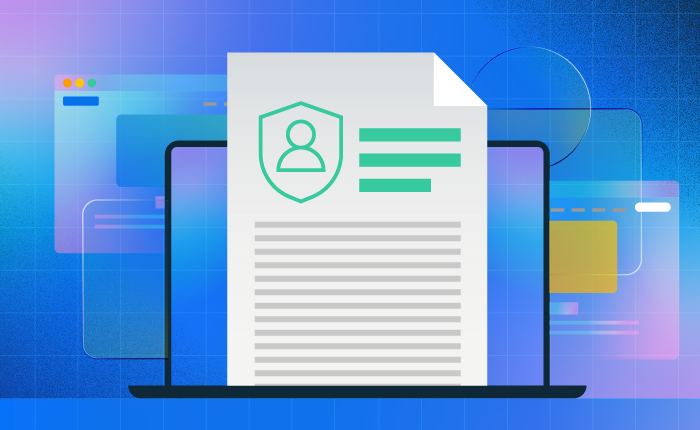The digital age is accelerating the exchange of personal data, highlighting data privacy as a fundamental human right. To ensure the protection of personal data, websites and applications are implementing privacy policies to transparently communicate how they plan to collect, store, use, and share information. In this blog post, we’ll discuss the legal requirements of privacy policies, their purpose, and what they should include.
Defining a Privacy Policy
A privacy policy is a document outlining how a company collects, uses, stores, and shares personal data from users. It acts as a legal agreement between a website or application and the user specifying the types of information collected, and the rights and responsibilities of both parties regarding personal data collection.
What Is a Privacy Policy’s Purpose?
A privacy policy’s primary purpose is providing an understanding to the customer regarding how and why personal data is collected. It informs users of the types of data collected by a website, how the site uses it, with whom the site shares it, and how the site secures it. It also informs users of their privacy rights like the right to access, correct, or delete the personal information a company holds on them.
A privacy policy helps build trust between the website or application and its users. Transparent communication about the collection and use of personal information helps users make informed decisions about sharing or withholding their data.
What Should a Privacy Policy Include?
A sufficiently transparent and comprehensive privacy policy should include the following information:
- Types of personal information the organization collects: The policy should specify the collection of information by type, like name, email address, health information, or credit card information.
- How the business will collect information: The policy should include a disclaimer on how the website will collect such information — through forms or cookies, for example.
- Purpose of personal information collection: The policy should specify the purpose of personal information collection, like marketing operations or providing a service.
- How the business uses personal information: The policy should explain how the company uses personally identifiable information (PII) for content personalization, processing transactions, or other purposes.
- How the business shares personal information: The policy should specify how the organization shares personal information with third-party service providers, advertisers, or others.
- Security measures: The policy should explain the safeguards in place protecting personal information from unauthorized access, use, or disclosure in the event of data breaches or other security incidents.
- User rights: The policy should specify the rights of users regarding their personal information, like the right to access, correct, or delete it.
- Contact information: The policy should include contact information for the website or application, like an email address or phone number.
How To Create a Privacy Policy
When creating a privacy policy, website and application owners should first identify the personal information they collect, how they use it, and with whom they share it. They should then go through the above list and draft a comprehensive and transparent policy including this information as well as details on security measures, privacy practices, and user rights. It’s important to ensure the policy complies with applicable laws and regulations, like the General Data Protection Regulation (GDPR) or the California Consumer Privacy Act (CCPA).
After creating the policy, they should display it in a prominent, easily accessible location on the organization’s web page or application. Website and application owners should regularly review and update the policy to ensure it remains accurate and up to date. Alternatively, they can seek assistance from legal professionals or privacy policy generators to ensure their policy meets all legal requirements.
Can you use a privacy policy template?
A privacy policy template is a pre-designed document outlining the key elements of a privacy policy. The template design is customizable and can be tailored to meet the specific needs of a website or application. They can be a helpful tool for those without extensive legal expertise or resources.
However, it’s important to note that privacy policy templates aren’t a one-size-fits-all solution, as they may not completely address all specific requirements of applicable laws and regulations. It’s important to review and customize the template to ensure it accurately reflects the data processing activities of the website or application and is compliant with applicable laws and regulations. DataGrail recommends working with legal professionals or a legal technology company like SixFifty. SixFifty creates tailored privacy policies to help meet specific company and legal requirements.
How To Manage a Privacy Policy
Managing a privacy policy involves regularly reviewing and updating it to continually ensure accuracy and compliance with applicable laws and regulations. Website and application owners should regularly assess data processing activities, update their policy accordingly, and send users notifications of any changes. They should also ensure employees are trained on the policy and understand their responsibilities for protecting personal information.
Companies should communicate any policy changes to users in a clear and easily understandable privacy notice. Additionally, owners should regularly review their third-party service providers to ensure they’re also compliant with applicable privacy laws and regulations. Effective privacy policy management helps companies maintain user trust and protect personal information.
Legal Requirements for Privacy Policies
Several data protection laws and regulations call for privacy policies. The most notable privacy laws requiring privacy policies are the European Union’s GDPR, and the CCPA in the United States. These laws require websites and mobile apps to implement comprehensive, transparent, and easily accessible privacy policies.
Before collecting, using, or sharing personal information, websites and applications must obtain user consent. User consent must be informed, meaning clear and understandable information about the collection, use, and sharing of personal information must be provided to users.
Privacy policies under GDPR
The GDPR is a comprehensive data privacy regulation applying to businesses operating within and outside the EU that process the personal data of EU residents. GDPR places significant emphasis on the importance of privacy policies and requires businesses to provide clear and transparent information to individuals about the processing of their personal data.
Under GDPR, privacy policies must include specific information like the legal basis for processing personal data, the types of personal data collected, the purposes of data processing, how long the data is held, and the individuals or organizations with which the collecting company shares the data. Privacy policies must also inform individuals of their rights under GDPR, like the right to access and rectify their personal data, and the right to erasure in certain circumstances.
In addition to providing this information, GDPR also requires businesses to obtain explicit consent from individuals before processing their personal data for certain uses, like marketing. This means businesses must provide clear and unambiguous information to individuals about the processing of their personal data, and obtain affirmative consent from them before processing it.
Overall, GDPR places importance on privacy policies and requires businesses to ensure they are clear, transparent, and compliant. Failure to comply with GDPR can result in significant fines and reputational damage, making it essential for businesses to ensure they have an effective, compliant privacy policy in place.
Privacy policies under CCPA
The CCPA is a privacy law giving California residents certain rights with respect to their personal information. Similar to GDPR, CCPA requires businesses to provide clear and transparent information to individuals about the processing of their personal data and places specific requirements on privacy policies.
Under CCPA, privacy policies must include certain information like the types of personal information collected, the collection and processing purposes, and the categories of third parties with whom the information is shared. Privacy policies must also provide California residents with information about their rights under CCPA, including the right to know what personal information is collected, the right to request personal information deletion, and the right to opt out of the sale of their personal information.
CCPA also requires businesses to make certain disclosures to individuals before collecting their personal information. Specifically, businesses must provide a notice at, or before, the point of collection describing the categories of personal information being collected and the usage purposes.
Overall, CCPA emphasizes transparency and gives California residents important personal information rights. Businesses subject to CCPA must ensure their privacy policies comply with the regulation, and should regularly review and update their policies to ensure ongoing accuracy.
Privacy Policies under CalOPPA
The California Online Privacy Protection Act (CalOPPA) is a privacy law requiring websites and online services to post a privacy policy disclosing how they collect, use, and share personal information from California residents. CalOPPA applies to any website or online service collecting PII from California residents, regardless of the business location.
Under CalOPPA, privacy policies must identify the categories of personal information they collect, the categories of third parties with whom they share the information, and how individuals can review and request changes to their personal information. Privacy policies must also include information about how the business responds to “Do Not Track” signals and how it complies with the Children’s Online Privacy Protection Act (COPPA).
CalOPPA requires businesses to make their privacy policies conspicuously available to individuals through a link on their website homepage or within the online service. Businesses failing to comply with CalOPPA can face penalties of up to $2,500 per violation.
Overall, CalOPPA emphasizes transparency and requires websites and online services to provide clear and understandable information to California residents about the collection, use, and sharing of their personal information. Businesses subject to CalOPPA should ensure their privacy policies are easily accessible and CalOPPA compliant.
Closing Out
Privacy policies are essential for protecting personal information and building trust between websites and applications and their users. Policies should be comprehensive, transparent, and easily accessible to users. Websites and applications must comply with legal requirements and obtain informed consent from users before collecting, using, or sharing personal information. The implementation of an effective privacy policy will help protect user information and build a loyal user base.
SixFifty’s All-US Privacy toolset helps organizations comply with every privacy law in the United States, including the CCPA. Organizations can easily and effectively generate customized legal documents written by top legal experts and required by varying privacy laws around the country. As privacy laws pass in new states, SixFifty updates their tools to include them so your documents are always up to date.

